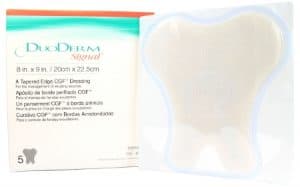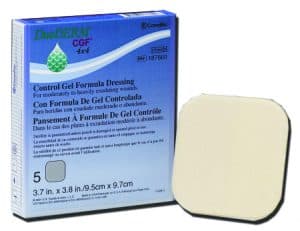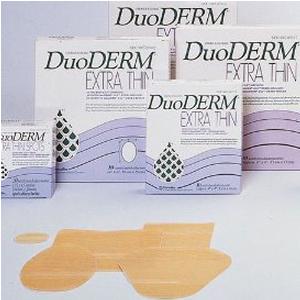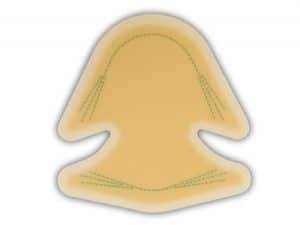The wound healing process is complex, and for a wound to heal correctly, it will need an optimum healing environment. This can be achieved by selecting and applying the right type of dressing. There are many wound care dressings on the market today, and one of the most commonly used is the hydrocolloid dressing. Here, we will discuss what hydrocolloid dressings are, when they are used, their advantages, and how to apply and remove them.
What are Hydrocolloid Dressings?
 Hydrocolloid dressings help maintain the optimal healing environment while protecting the wound, so the body’s own enzymes can get to work for proper healing. These dressings’ unique design allows it to absorb wound exudate and form a gel over the wound site. The result is a self-adhering and waterproof wound dressing that resembles an absorbent, flexible wafer. These advanced wound dressings come in a variety of sizes and thicknesses. They are available with or without adhesive borders, such as the DuoDERM CGF Adhesive Border Hydrocolloid Dressing and the DuoDERM CGF Sterile Dressing.
Hydrocolloid dressings help maintain the optimal healing environment while protecting the wound, so the body’s own enzymes can get to work for proper healing. These dressings’ unique design allows it to absorb wound exudate and form a gel over the wound site. The result is a self-adhering and waterproof wound dressing that resembles an absorbent, flexible wafer. These advanced wound dressings come in a variety of sizes and thicknesses. They are available with or without adhesive borders, such as the DuoDERM CGF Adhesive Border Hydrocolloid Dressing and the DuoDERM CGF Sterile Dressing.
When are Hydrocolloid Dressings Used?
Hydrocolloid dressings have the best effect on clean, uninfected wounds, have medium thickness, and have low to moderate drainage. Since these wound dressings are waterproof and flexible, they are an excellent choice to protect newly or partially healed wounds when the skin is still intact. Many times smaller hydrocolloid dressings are used for those suffering from acne. If a pimple is raised or has visible pus, the hydrocolloid dressing can absorb the fluid and flatten out the spot. Hydrocolloid dressings can decrease the severity of the pimple, its redness, oiliness, and dark pigmentation.
Using hydrocolloid dressings helps insulate the wound site allowing the body to consume less energy to heal. An important note is that these advanced wound dressings are not suitable for wounds with high exudate.
Advantages and Disadvantages of Hydrocolloid Dressings
Advantages
 Hydrocolloid dressings can help promote faster healing of wounds for a variety of reasons.
Hydrocolloid dressings can help promote faster healing of wounds for a variety of reasons.
- They provide the optimal healing environment, keeping the wound site moist and allowing the body’s enzymes to get to work.
- They are impermeable to protect against bacteria and other contaminants.
- They do not stick to the wound site, but rather the healthy surrounding skin.
- They can be left on longer than most other wound dressings, requiring less frequent changes.
- They are flexible for the body areas that are difficult to dress, such as the heels and elbows.
- They can be used alongside venous compression products.
- They come in a wide selection of shapes and sizes.
Disadvantages
Although there are many benefits of using hydrocolloid dressings, it is essential to note that there are also some disadvantages.
- They are not suitable for wounds that have heavy exudate as they may become forced out of position.
- The excess moisture may lead to hypergranulation or maceration of the surrounding skin.
- Some of the dressing may stick to the wound site and cause trauma to the soft healing tissue.
- The dressing may have an unpleasant odor upon changing if some of it sticks to the healing wound.
- These wound dressings can curl or roll up on the edges.
- Assessing the wound site can be difficult due to the opaqueness of the hydrocolloids.
How to Apply Hydrocolloid Dressings
 Your doctor should provide you with detailed instructions on applying the hydrocolloid dressings that you will be using for your particular wound. However, there are some best practices to take and a general process to follow.
Your doctor should provide you with detailed instructions on applying the hydrocolloid dressings that you will be using for your particular wound. However, there are some best practices to take and a general process to follow.
- Always wash your hands before handling wound care dressings and supplies.
- Put on a pair of surgical or exam gloves.
- If necessary, remove any current dressing and discard it. (See How to Remove Hydrocolloid Dressings below)
- Use an effective saline solution to clean the wound site and surrounding skin.
- Pat the wound site and the surrounding skin dry with sterile gauze.
- Remove and discard the gloves and put on a new pair.
- Use a quality moisture barrier to the periwound skin.
- Before removing the backing from the hydrocolloid dressing, hold it between your hands to warm it to adhere better.
- Remove the backing and center the dressing over the wound site, smoothing it from the center outward, pressing gently to improve adhesion.
- If the wound dressing does not have an adhesive border, secure it with tape.
How to Remove Hydrocolloid Dressings
Removing a hydrocolloid dressing from a wound site is very easy. However, taking great precautions is crucial as you do not want to cause any more damage to the affected and surrounding areas.
- Gently press down on the skin at the edge of one side of the adhesive border or tape to allow it to lift slightly.
- Using your fingers, slowly lift the edges and continue around until the adhesive is free from the skin.
- Gently and carefully, lift the hydrocolloid dressing away from the wound site.
- If you are changing the wound dressing, refer to the steps above to apply a new bandage.
Personally Delivered carries a wide variety of hydrocolloid dressings. For questions or help selecting the right wound care dressing for your wound type, our Personally Delivered Product Experts are just a phone call away and ready to help.





